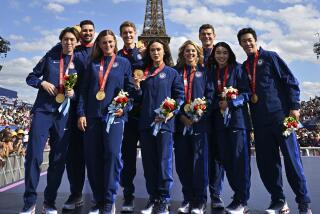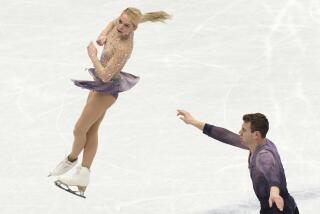Russian Pairs Are Two Good : Figure skating: Gold medalists in 1988, Ekaterina Gordeeva and Sergei Grinkov, win again, with ’92 winners second.
- Share via
HAMAR, Norway — Pairs figure skating might never have been performed at a higher level in the Winter Olympics than it was Tuesday night in the Olympic Amphitheatre, which was one reason it was so difficult to decide who deserved to win.
In the first meeting in the Olympics between past champions, eight of the nine judges voted for Ekaterina Gordeeva and Sergei Grinkov, the 1988 gold medalists, in the freestyle program, while the crowd preferred Natalia Mishkutenok and Artur Dmitriev, the 1992 gold medalists, rewarding them with a standing ovation.
Because the judges determine the winners, Gordeeva and Grinkov will take gold medals home to Moscow, or perhaps to Tampa, Fla., where they live when touring in the United States.
It was a superb night for other pairs, especially bronze medalists Isabelle Brasseur and Lloyd Eisler of Canada, fourth-place Evgenia Shishkova and Vadim Naumov of Russia and fifth-place Jenni Meno and Todd Sand of Costa Mesa.
But they were amateurs compared to the first two Russian pairs--literally, because Gordeeva and Grinkov and Mishkutenok and Dmitriev embarked upon lucrative professional careers after winning their gold medals and before returning to the Olympics to challenge one another.
Tamara Moskvina, the rambunctious coach who handles Mishkutenok and Dmitriev, predicted the outcome after a practice Tuesday.
“I’m friendly with the judges, but I don’t think their inclination is toward my couple,” she said. “Some pairs get the marks, others get the renown.”
With little argument from the rest of the world, Russians usually get both. They dominated pairs skating in the Soviet Union when that country dominated the event, winning eight consecutive Winter Olympic championships between 1964 and ’92 and finishing first and second in five competitions.
To find real competition, the Russians have had to look within, splitting into the Moscow and St. Petersburg schools. When Moscow took a 5-4 lead in Olympic gold medals Tuesday night, Moskvina feigned indifference.
“We are from St. Petersburg, the capital of intelligence,” she said.
She is smart enough to figure out that this could be the end of pairs superiority for the Russians, whose best figure skaters, now that they have more freedom to choose their disciplines, are deciding--like the Americans--to go into the higher-profile individual competitions.
Six years, and one infant daughter, since they won in 1988 at Calgary, Canada, Gordeeva, 22, and Grinkov, 27, have seen the future and decided they are not part of it.
Gordeeva said the Russians will always be strong, but she added that they will have to look over their shoulders at the Canadians and the Americans. She could be right in the case of Meno and Sand, whose coach, John Nicks, said: “I think this is a pair on the upward rise. They haven’t been together that long.”
In 1993, their first full season together, they finished fifth in the world. Their competition last year did not include Gordeeva and Grinkov or Mishkutenok and Dmitriev. If not for the rule allowing professionals to return, Meno and Sand might have won bronze medals in these Games.
Nicks might have found joy in that, but as the United States’ most successful pairs coach, he seemed enthused about the return of the Russians. He prefers Gordeeva and Grinkov, but he believed that the perfect score of 6.0 that the Russian judge gave them for artistic impression was overdoing it. Nicks would not have argued if Mishkutenok and Dmitriev had won.
“Gordeeva and Grinkov are what I would call a purist’s pair,” he said. “But those who prefer imaginative choreography, gimmicks and new ideas, they prefer the second Russians.”
In general, Nicks said, the skating was wonderful.
An exception was the nasty spill taken by Germany’s Mandy Woetzel amid a relatively easy set of spirals, forcing her and partner Ingo Steuer to retire. She was taken to a hospital, where she required three stitches in her chin.
More to Read
Go beyond the scoreboard
Get the latest on L.A.'s teams in the daily Sports Report newsletter.
You may occasionally receive promotional content from the Los Angeles Times.






